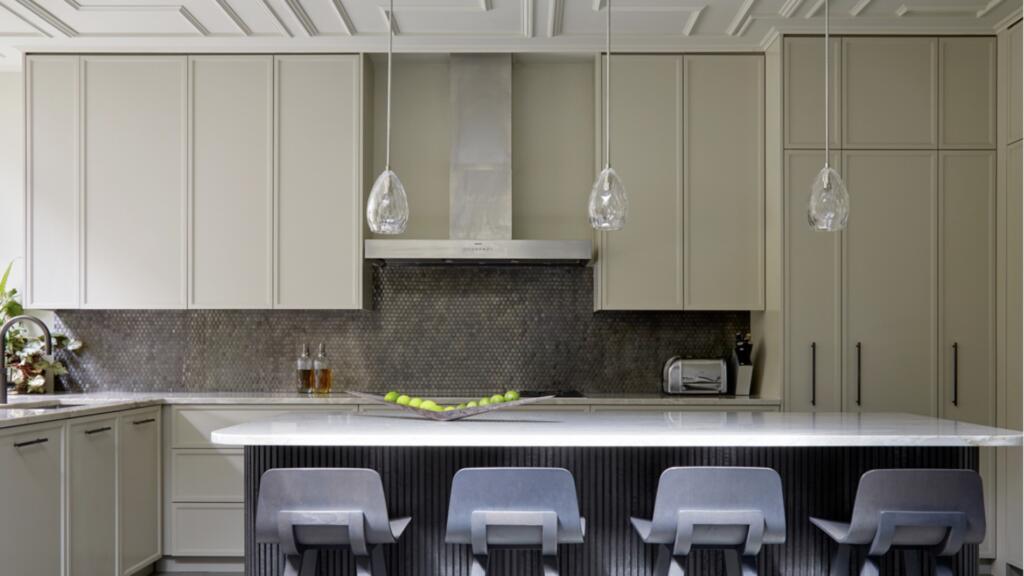
How much does planning permission cost? We explain the fees
Sarah Harley
Wondering just what’s involved with getting approval for your build project? We’ve got some answers.
If you’re one of the many homeowners across the UK feeling it might be wiser to renovate or build a new home than dip your toe into an uncertain housing market, you may be wondering about planning permission.
The red tape associated with planning permission can often seem daunting but, when you unravel it, it’s not as problematic as you think.
If you’re one of the many homeowners across the UK feeling it might be wiser to renovate or build a new home than dip your toe into an uncertain housing market, you may be wondering about planning permission.
The red tape associated with planning permission can often seem daunting but, when you unravel it, it’s not as problematic as you think.
 Credit: Shutterstock/Fotogrin
Credit: Shutterstock/FotogrinTo help you take the next steps towards turning your property dreams into reality, we’ve done the legwork and obtained expert advice that answers the most important questions that people have. Read on to find out just what planning permission is all about.
In simple terms, when granted, planning permission is the legal right to undertake a specific piece of work to your property or to construct a new building.
It’s given by your local authority rather than the Government. Under the various town and country planning acts for each nation, Parliament gives the main responsibility for providing permission to the planning departments of each local authority.
 Credit: Shutterstock/Daniel Tedavoysana
Credit: Shutterstock/Daniel TedavoysanaAlthough each nation has its own variations in policies, one element is the same – if you don’t get planning permission, the consequences can be costly. You may be required to take down whatever you have built.
We asked Brian Berry, Chief Executive of the Federation of Master Builders, to explain why we need to apply for planning permission when we own land and property.
“Planning permission exists to ensure that new developments and changes to existing properties are in line with local planning policies and regulations,” he explains. “It also exists to ensure that new developments are built in a way that does not have a negative impact on the local community. It can also take into account environmental impacts.”
My own experience
I remember asking a similar question when I applied for planning permission on the first building project I undertook. I was reminded by an architect that although we may currently own the property, it’s rare that we own it forever.
We are probably better off thinking of ourselves as temporary custodians. When you accept that planning rules exist to ensure our homes and land are protected not just for ourselves, but for future generations and the environment, it becomes a little easier to understand why you need permission.
It’s common sense that if you are looking to apply for planning permission on your own home, you can make the application.
However, if you are the home or landowner, you can also ask your architect, builder, solicitor or a planning consultant to apply on your behalf.
What’s perhaps more surprising to know is that if you’ve got your eye on a piece of land you don’t yet own, – but you don’t yet own the land – you can still apply for planning permission to build on it. But be warned, you still have obligations.
 Credit: Shutterstock/Skyeye.agency
Credit: Shutterstock/Skyeye.agencyThe following people must be informed about a planning application relating to land or buildings you have an interest in:
What is a planning consultant and should you hire one?
Although you may groan at the thought of adding another professional fee to your budget, the role of a planning consultant can be invaluable if you’re embarking on a project that may have potential issues, such as renovating a listed building.
A planning consultant works on your behalf, submitting the application and then dealing with the it until approval is granted. You will still be heavily involved, but a consultant will have the experience and knowledge to help deal with the feedback and comments that may be made during the process.
Speaking from experience, hiring a consultant based in your area will also ensure they are up to date with the local regulations and their local knowledge could potentially save you a rejection.
I considered it money well spent when I worked on my Grand Designs project. I was lucky enough to find a consultant who had previously run the planning department at my local authority – the planning equivalent of a gamekeeper-turned-poacher.
While it was outside his power to change any decision, his prior knowledge helped steer me towards considering designs that were more likely to obtain planning approval. It not only saved time and money, but also made the process less stressful.
 Credit: Shutterstock/Peopleimages.com
Credit: Shutterstock/Peopleimages.comIf you’re a residential homeowner, there are three main areas where you may require planning permission:
Although this may seem a relatively small list, there are extra nuances in each area that can make it more complex.
An extension, for example, may fall into the category of permitted development rights. On the other hand, if your building is listed or in a conservation area, you may need planning permission for even smaller works like changing windows, doors or guttering, as well as demolition of buildings or structures (such as walls or fences).
The simple answer is yes. For domestic projects, the main ones to be aware of are householder planning consent, full planning permission and permitted development rights.
Berry explains: “Homeowner planning consent is a type of planning permission that allows homeowners to carry out certain small-scale changes or extensions to their homes without having to go through the full planning process.
“Full planning consent is detailed planning permission required for larger scale developments such as new buildings or significant modifications to new buildings.”
Homeowner planning consent can cover, but is not limited to, works such as extensions, loft conversions, swimming pools, garages and porches.
Works within the full planning permission category may include building a new property in your garden, making changes to a flat, switching use of part of a building to commercial use, demolition, or rebuilding.
 Credit: Shutterstock/Little Red Dragon
Credit: Shutterstock/Little Red DragonWhere the waters can get a little muddier is when it comes to permitted development rights versus homeowner planning consent. Both categories can cover extensions, conservatories, roof alterations, porches and outbuildings.
It usually comes down to the size of the proposed works, if there have been previous developments on the property or within the curtilage (the area of land around it) and if the property is listed or in a conservation area.
Work to flats, maisonettes and other buildings are also excluded from permitted development rights, falling instead under homeowner planning consent or full planning permission.
If you want extra help to check which category your project may fall into, a list of 50 common home building projects has been created on the Planning Portal, which outlines some of the most popular types of build projects and the permission they will need.
No. The rules and regulations are slightly different in each nation – England, Scotland, Wales and Northern Ireland – especially when it comes to specifics such as fees.
Each authority will also have its own set of policies regarding commercial and residential development in the area. Your project will be assessed against all these criteria.
Although each local authority is responsible for planning approval, here’s where you can find details of the national guidelines.
For any building project, the best advice is always to speak to your local planning department first – even before you speak to a builder or architect.
Even if you only have a rough idea of what you would like to do, speaking to the planners will help establish what is permitted in your area. It will also give you a much clearer idea on what you can give as a brief to an architect or builder.
For example, you may not be aware you are in a local conservation area, or that your home was previously extended before you owned it – all of which could significantly affect your plans.
Establishing a clear set of guidelines will allow you to move ahead with more confidence, and will always save you time and money. You could even discover you don’t need planning permission.
 Credit: Shutterstock/Fizkes
Credit: Shutterstock/FizkesOften a complex matter, we asked Berry to explain how planning works when it involves a listed building.
“Anyone living in a listed building must obtain listed building consent from their local authority before starting any building work,” says Berry. “This covers alterations or extensions that will affect the building’s character as a building of special architectural or historic interest.
“It is a criminal offence to carry out work requiring listed building consent without obtaining it first,” he warns. “You might also need consent to carry out work to any outbuildings in the grounds if your home is listed.”
So if you have listed building consent, does that mean you don’t need planning permission? Actually, you may need both.
“Planning permission might be needed in addition to listed building consent,” adds Berry. “Contact the planning or conservation officers at your local planning authority to find out.”
If you own a listed building, you may also need to apply for planning permission for projects that would normally be considered exempt. It’s an area we recommend you investigate thoroughly before you proceed.
When it comes to working with listed buildings, I’d suggest it’s far better to take the approach of assuming you will need to get everything fully approved. When working on my Grand Designs project, I was aware we’d need to get Listed Building approval for external alterations.
What came as more of a shock was being told we’d also have to pay for an archaeologist to be on site from the moment we started to just dig foundations. It turned out we may have been sited on a Roman encampment and so the grounds, as well as the buildings, needed assessing. Thankfully nothing of interest was found and we could proceed.
For more information on listed buildings, visit:
CADW – Wales
Historic England – England
Historic Environment Scotland – Scotland
Department for Communities – Northern Ireland
Inspired to know more? We’ll be adding to our Planning Permission series over the coming weeks with a detailed look at fees and a timeline explaining how long it may take and what comes next.
While information is correct at the time of publication, amendments are currently being proposed to the National Planning Policy Framework in England.
The consultation period for these ends in April 2023 and we’ll let you know about any changes as soon as they are announced.

Written by Sarah Harley she/her
Published: Updated:
Since first picking up a paintbrush and experiencing the joy of re-decorating her bedroom in a questionable red, white and grey scheme as a young teenager, Sarah Harley was hooked on the world of interior design. This obsession even led to a real life ‘Grand Designs’ project in 2005 when she donned a pink hard hat and appeared on TV screens, project managing the renovation and extension of a Grade II listed 17th century Folly in South Wales.
Throughout her career, Sarah has gained an array of experience in several different roles, ranging from copywriting, PR, events management and photography to interior design and home staging. With her two passions being the written word and the joys of a beautifully designed home, Sarah’s mission is to open the door on the world of interiors, inviting readers in to help them work their way through the vast choice of products, ideas and trends so that their own homes can reach their full potential.

Sarah Harley

Sarah Harley

Sarah Harley

Joy Archer